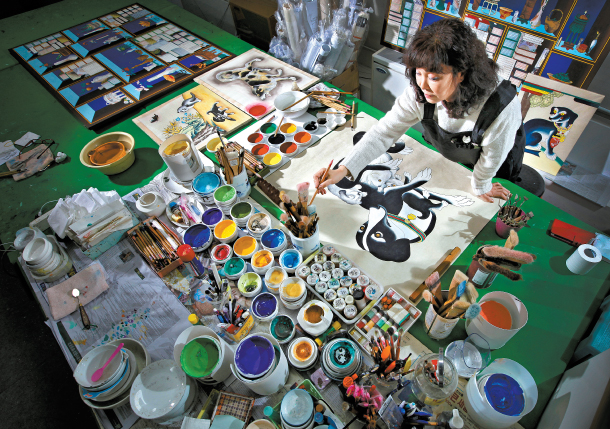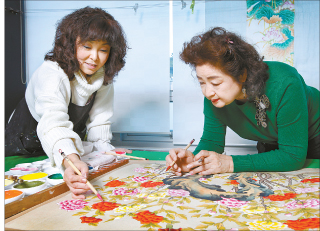[ZOOM KOREA] Reviving the art of New Year’s paintings

To celebrate the year of the golden dog, artist Nam Jung-ye works on traditional paintings featuring dogs in her workroom in Nagwon-dong, central Seoul. [PARK SANG-MOON]
Nam Jung-ye, a folk painter who has been working for 20 years, is especially busy during the New Year, as she draws sehwa for people who still follow the tradition. At her workroom in Nagwon-dong in central Seoul, she displays a series of sehwa featuring dogs, including the Korean breed Sapsaree, white dogs, black dogs and yellow dogs, all displayed to greet 2018, the year of the golden dog. Since Sapsaree means “to expel misfortune” in Korean, they are frequently depicted in sehwa paintings.
No one knows for sure the origins of sehwa, but it has been recorded that palace painters in the early Joseon Dynasty (1392-1910) were the first to draw them to celebrate the New Year. The painters from the Dohwaseo (palace painting bureau) drew them and presented them to the King, and he would pass them out to his relatives and royal subjects. The painters also made paintings to chase away evil spirits and hung them on palace doors and gateways.
The sehwa made to chase away bad energy usually depict animals such as dragons, tigers, roosters, dogs, or haetae, a mythical horned lion, and are posted throughout the house, as each animal has a different meaning. Tigers or dragons were said to protect the house from the demons, so they were hung on the main gates. Roosters were hung on the inner gates to light up the spirits of the house, and dogs were placed on the doors of barns to guard against thieves. Haetae were placed next to the palace’s stone stairs or in the kitchens, as they were said to prevent fires.

Nam Jung-ye, left, explains the importance of color impressions in folk paintings to Kumico Kim, who traveled from Japan to learn from the folk artist.[PARK SANG-MOON]
Although Nam loved to draw at a young age, she did not begin making folk paintings until her mid-thirties. She majored in ceramics in college and taught in a middle school after graduation. Before she became interested in folk paintings, she worked on watercolor paintings. Those who saw her work complimented her on her use of colors.
It took a while for Nam to learn to like folk paintings. She had a prejudice that old paintings were gloomy and dull. However, that dissolved when she began to actually paint them herself. She found that she was attracted to the witty expressions and vivid colors that were specific to folk paintings. She was captivated by their charisma and there were days when she did nothing else but work on her paintings all day long. She worked hard to accurately depict the style of the old paintings and mastered whatever works she could get her hands on, regardless of how small or large the paintings were.
In 2004, she taught folk painting at the National Folk Museum of Korea. Up until that point, there wasn’t any creativity in her works and her pieces were limited to copying paintings that were many years old. Nam felt the need to show off her creativity and originality as an artist in her paintings. What she chose to do was to add a contemporary touch and her own aesthetic quality to the traditional paintings.

Nam’s folk paintings, from left, “Dreaming Tiger,” “Baby Tiger,” “Chaekgeori,” and “Pine Tree.” [PARK SANG-MOON]
Nam was mostly interested in drawing paintings of tigers, peonies, and books. All the paintings have a strong contemporary aesthetic. The paintings of books are especially popular with foreigners.
Many Western paintings are based on perspective drawing, so objects appear to recede at a distance. But one of Nam’s distinctive characteristics is that the objects in her works all have various perspectives. Some are drawn as if the artist has seen her subjects from above, while some flip the concept of perspective drawing, so that the object in a distance might be larger than those in the front.
Recently, folk paintings are becoming popular among many Koreans. Many people who walk the streets of Insa-dong in central Seoul with black brush cases on their shoulders are those who come to the neighborhood to study folk painting. As the painting is based on five traditional colors, the colors are bright and their impressions are animated. Since the paintings are sketched first, they are easy to learn and complete, so studying the paintings has become increasingly popular.
Looking closely at Nam’s works, it is easy to tell that the artist has excellent aesthetic sense. She hopes that folk paintings will be as loved in the modern day as they were by the people in the Joseon era.
There are even people who seek out Nam specifically in order to study the art of folk paintings. Kumico Kim has visited Nam’s workroom three to four times every year over the past eight years for private lessons, since there’s hardly a place suitable for her to learn about folk paintings in Japan. Therefore, she has no choice but to visit Korea to study and improve her skills.
Nam has said that she feels proud of the art she produces, and promises to do her best until the paintings are hung in every house of Korea. She wishes that people will break free of the stereotypes they hold about folk paintings and enjoy the paintings in their everyday lives, just as she does. If the custom of presenting each other with paintings for the New Year comes back, there is no doubt it will be another beautiful way to preserve and restore Korea’s cultural traditions.
BY PARK SANG-MOON [moonpark@joongang.co.kr]










with the Korea JoongAng Daily
To write comments, please log in to one of the accounts.
Standards Board Policy (0/250자)